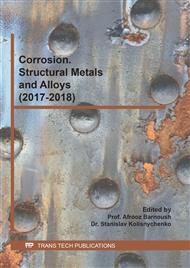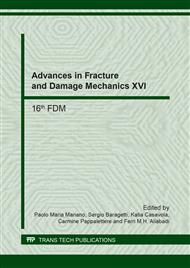[1]
S Lynch, Hydrogen embrittlement phenomena and mechanisms. Corros Rev, 30, 105-123, (2012).
Google Scholar
[2]
JJ Rimoli, M Ortiz, A three-dimensional multiscale model of intergranular hydrogen-assisted cracking. Philosophical Magazine, 90(21), 2939-2963, (2010).
DOI: 10.1080/14786431003752134
Google Scholar
[3]
N. Schclar, Anisotropic analysis using boundary elements. Topics in Engineering, vol. 20, Computational Mechanics Publications, (1994).
Google Scholar
[4]
V Gulizzi, A Milazzo, I Benedetti, Fundamental solutions for general anisotropic multi-field materials based on spherical harmonics expansions. International Journal of Solids and Structures, 100, 169-186, (2016).
DOI: 10.1016/j.ijsolstr.2016.08.014
Google Scholar
[5]
MH Aliabadi. The Boundary Element Method: Applications in Solids and Structures, Vol. 2 Wiley (2002).
Google Scholar
[6]
I Benedetti, MH Aliabadi, A three-dimensional grain boundary formulation for microstructural modeling of polycrystalline materials. Computational Materials Science, 67, 249-260, (2013).
DOI: 10.1016/j.commatsci.2012.08.006
Google Scholar
[7]
V Gulizzi, A Milazzo, I Benedetti, An enhanced grain-boundary framework for computational homogenization and micro-cracking simulations of polycrystalline materials. Computational Mechanics, 56(4), 631-651, (2015).
DOI: 10.1007/s00466-015-1192-8
Google Scholar
[8]
I Scheider, M Pfuff, W Dietzel, Simulation of hydrogen assisted stress corrosion cracking using the cohesive model. Engineering Fracture Mechanics, 75(15), 4283-4291, (2008).
DOI: 10.1016/j.engfracmech.2007.10.002
Google Scholar
[9]
S Serebrinsky, EA Carter, M Ortiz,. A quantum-mechanically informed continuum model of hydrogen embrittlement. Journal of the Mechanics and Physics of Solids, 52(10), 2403-2430, (2004).
DOI: 10.1016/j.jmps.2004.02.010
Google Scholar
[10]
GK Sfantos, MH Aliabadi, A boundary cohesive grain element formulation for modelling intergranular microfracture in polycrystalline brittle materials. International journal for numerical methods in engineering, 69(8), 1590-1626, (2007).
DOI: 10.1002/nme.1831
Google Scholar
[11]
GK Sfantos, MH Aliabadi,. Multi-scale boundary element modelling of material degradation and fracture. Computer Methods in Applied Mechanics and Engineering, 196(7), 1310-1329, (2007).
DOI: 10.1016/j.cma.2006.09.004
Google Scholar
[12]
I Benedetti, MH Aliabadi, A three-dimensional cohesive-frictional grain-boundary micromechanical model for intergranular degradation and failure in polycrystalline materials. Computer Methods in Applied Mechanics and Engineering, 265, 36-62, (2013).
DOI: 10.1016/j.cma.2013.05.023
Google Scholar
[13]
I Benedetti, MH Aliabadi, Multiscale modeling of polycrystalline materials: A boundary element approach to material degradation and fracture. Computer Methods in Applied Mechanics and Engineering, 289, 429-453, (2015).
DOI: 10.1016/j.cma.2015.02.018
Google Scholar
[14]
I Benedetti, V Gulizzi, V Mallardo, A grain boundary formulation for crystal plasticity. International Journal of Plasticity, 83, 202-224, (2016).
DOI: 10.1016/j.ijplas.2016.04.010
Google Scholar
[15]
I Benedetti, F Barbe, Modelling Polycrystalline Materials: An Overview of Three-Dimensional Grain-Scale Mechanical Models. Journal of Multiscale Modelling, 5(01), (2013).
DOI: 10.1142/s1756973713500029
Google Scholar
[16]
I Simonovski and L Cizelj. Towards modeling intergranular stress corrosion cracks on grain size scales. Nuclear Engineering and Design, 246, 107–114, (2012).
DOI: 10.1016/j.nucengdes.2011.08.032
Google Scholar



